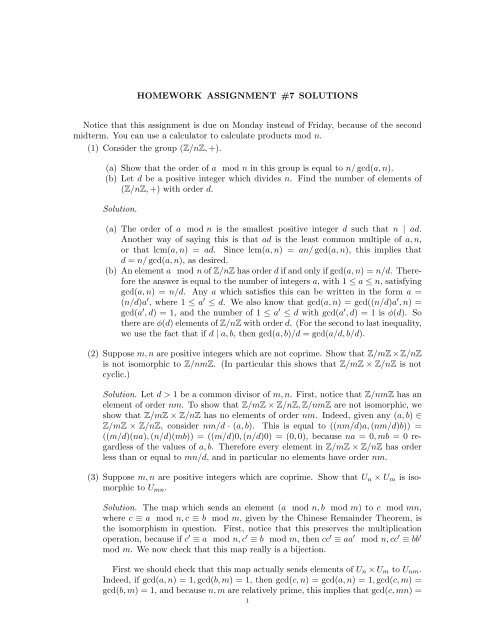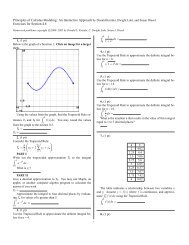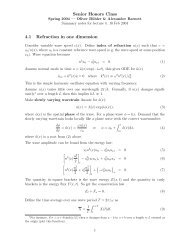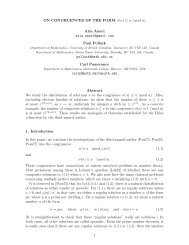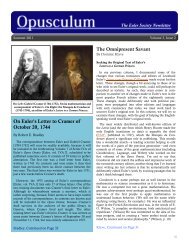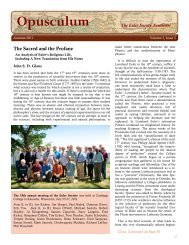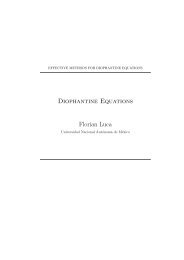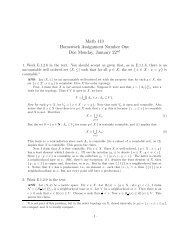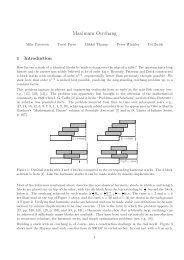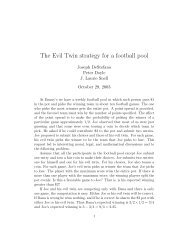HOMEWORK ASSIGNMENT #7 SOLUTIONS Notice that this ...
HOMEWORK ASSIGNMENT #7 SOLUTIONS Notice that this ...
HOMEWORK ASSIGNMENT #7 SOLUTIONS Notice that this ...
Create successful ePaper yourself
Turn your PDF publications into a flip-book with our unique Google optimized e-Paper software.
<strong>HOMEWORK</strong> <strong>ASSIGNMENT</strong> <strong>#7</strong> <strong>SOLUTIONS</strong><br />
<strong>Notice</strong> <strong>that</strong> <strong>this</strong> assignment is due on Monday instead of Friday, because of the second<br />
midterm. You can use a calculator to calculate products mod n.<br />
(1) Consider the group (Z/nZ, +).<br />
(a) Show <strong>that</strong> the order of a mod n in <strong>this</strong> group is equal to n/ gcd(a, n).<br />
(b) Let d be a positive integer which divides n. Find the number of elements of<br />
(Z/nZ, +) with order d.<br />
Solution.<br />
(a) The order of a mod n is the smallest positive integer d such <strong>that</strong> n | ad.<br />
Another way of saying <strong>this</strong> is <strong>that</strong> ad is the least common multiple of a, n,<br />
or <strong>that</strong> lcm(a, n) = ad. Since lcm(a, n) = an/ gcd(a, n), <strong>this</strong> implies <strong>that</strong><br />
d = n/ gcd(a, n), as desired.<br />
(b) An element a mod n of Z/nZ has order d if and only if gcd(a, n) = n/d. Therefore<br />
the answer is equal to the number of integers a, with 1 ≤ a ≤ n, satisfying<br />
gcd(a, n) = n/d. Any a which satisfies <strong>this</strong> can be written in the form a =<br />
(n/d)a ′ , where 1 ≤ a ′ ≤ d. We also know <strong>that</strong> gcd(a, n) = gcd((n/d)a ′ , n) =<br />
gcd(a ′ , d) = 1, and the number of 1 ≤ a ′ ≤ d with gcd(a ′ , d) = 1 is φ(d). So<br />
there are φ(d) elements of Z/nZ with order d. (For the second to last inequality,<br />
we use the fact <strong>that</strong> if d | a, b, then gcd(a, b)/d = gcd(a/d, b/d).<br />
(2) Suppose m, n are positive integers which are not coprime. Show <strong>that</strong> Z/mZ×Z/nZ<br />
is not isomorphic to Z/nmZ. (In particular <strong>this</strong> shows <strong>that</strong> Z/mZ × Z/nZ is not<br />
cyclic.)<br />
Solution. Let d > 1 be a common divisor of m, n. First, notice <strong>that</strong> Z/nmZ has an<br />
element of order nm. To show <strong>that</strong> Z/mZ × Z/nZ, Z/nmZ are not isomorphic, we<br />
show <strong>that</strong> Z/mZ × Z/nZ has no elements of order nm. Indeed, given any (a, b) ∈<br />
Z/mZ × Z/nZ, consider nm/d · (a, b). This is equal to ((nm/d)a, (nm/d)b)) =<br />
((m/d)(na), (n/d)(mb)) = ((m/d)0, (n/d)0) = (0, 0), because na = 0, mb = 0 regardless<br />
of the values of a, b. Therefore every element in Z/mZ × Z/nZ has order<br />
less than or equal to mn/d, and in particular no elements have order nm.<br />
(3) Suppose m, n are positive integers which are coprime. Show <strong>that</strong> Un × Um is isomorphic<br />
to Umn.<br />
Solution. The map which sends an element (a mod n, b mod m) to c mod mn,<br />
where c ≡ a mod n, c ≡ b mod m, given by the Chinese Remainder Theorem, is<br />
the isomorphism in question. First, notice <strong>that</strong> <strong>this</strong> preserves the multiplication<br />
operation, because if c ′ ≡ a mod n, c ′ ≡ b mod m, then cc ′ ≡ aa ′ mod n, cc ′ ≡ bb ′<br />
mod m. We now check <strong>that</strong> <strong>this</strong> map really is a bijection.<br />
First we should check <strong>that</strong> <strong>this</strong> map actually sends elements of Un × Um to Unm.<br />
Indeed, if gcd(a, n) = 1, gcd(b, m) = 1, then gcd(c, n) = gcd(a, n) = 1, gcd(c, m) =<br />
gcd(b, m) = 1, and because n, m are relatively prime, <strong>this</strong> implies <strong>that</strong> gcd(c, mn) =<br />
1
2 <strong>HOMEWORK</strong> <strong>ASSIGNMENT</strong> <strong>#7</strong> <strong>SOLUTIONS</strong><br />
1. So c mod mn really is an element of Umn. The map is a bijection because it has<br />
inverse c mod mn ↦→ (c mod n, c mod m).<br />
(4) (a) Show <strong>that</strong> 5 is a primitive root mod 18.<br />
(b) Which powers of 5 mod 18 are also primitive roots mod 18?<br />
Solution.<br />
(a) There are a variety of ways to show 5 is primitive mod 18; we will use the<br />
condition which asks us to check 5 φ(18)/q ≡ 1 mod 18 for all prime divisors q<br />
of φ(18). Since φ(18) = 6, we want to calculate 5 6/2 , 5 6/3 mod 18. These are<br />
equal to 17, 7 mod 18, respectively, neither of which are ≡ 1 mod 18, so 5 is<br />
primitive mod 18.<br />
(b) Because U18 has order φ(18) = 6, the primitive elements of U18 are those of<br />
order 6. Furthermore, U18 is cyclic, so by the first problem in <strong>this</strong> assignment,<br />
the elements of order 6 are those powers of 5 whose exponents are relatively<br />
prime to 6; ie, 5 1 , 5 5 mod 18. One checks <strong>that</strong> 5 5 ≡ 11 mod 18.<br />
(5) p = 229 is a prime. How many elements of U229 are<br />
(a) squares in U229?<br />
(b) cubes in U229?<br />
(c) eighth powers in U229?<br />
Solution. Let g be primitive mod 229.<br />
(a) We want to count the number of g i such <strong>that</strong> g i = g 2k for some integer k. In<br />
other words, we want to determine the total number of i mod 228 such <strong>that</strong><br />
i ≡ 2k mod 228. Since 2 | 228, there are exactly 228/2 = 114 such i, so there<br />
are 114 squares in U229.<br />
(b) This time we want to find the number of i satisfying i ≡ 3k mod 228. Since<br />
3 | 228, there are exactly 228/3 = 76 cubes in U229.<br />
(c) This time we want to find the number of i satisfying i ≡ 8k mod 228. Since<br />
gcd(8, 228) = 4, <strong>this</strong> has a solution exactly when 4 | i; therefore there are<br />
228/4 = 57 eighth powers in U229.<br />
(6) Show <strong>that</strong> 112 is a primitive root mod 11, but not a primitive root mod 121. Find<br />
a primitive root mod 121.<br />
Solution. 112 ≡ 2 mod 11, so we will check <strong>that</strong> 2 is primitive mod 11. Since<br />
φ(11) = 10, we want to check <strong>that</strong> 2 10/2 , 2 10/5 ≡ 1 mod 11. Indeed, 2 5 ≡ −1<br />
mod 11, 2 2 ≡ 4 mod 11, so 2, and hence 112, is primitive mod 11.<br />
To check <strong>that</strong> 112 is not primitive mod 121, we check <strong>that</strong> 112 10 ≡ 1 mod 121, so<br />
<strong>that</strong> 112 has order 10, not φ(121) = 110, in U121. Using whatever favorite method<br />
you have to calculate 112 10 mod 121, one checks <strong>that</strong> 112 10 ≡ 1 mod 121.<br />
By the proof of the fact <strong>that</strong> U p 2 is cyclic, we know <strong>that</strong> if g is not primitive mod<br />
p 2 , then g + p is. In our case, g = 112, p = 11, so g + p = 123 ≡ 2 mod 121 is cyclic<br />
mod 121. So 2 is primitive mod 121. (As a matter of fact, any number g with g ≡ 2<br />
mod 11, g ≡ 112 mod 121, would work.)
<strong>HOMEWORK</strong> <strong>ASSIGNMENT</strong> <strong>#7</strong> <strong>SOLUTIONS</strong> 3<br />
(7) (a) True or false: suppose p, q are odd primes. If g is a primitive root mod p and<br />
mod q, then g is a primitive root mod pq.<br />
(b) True or false: suppose p is an odd prime, e ≥ 1. If g is a primitive root mod 2<br />
and mod p e , then g is a primitive root mod 2p e .<br />
Solution.<br />
(a) False. In general Upq is not even cyclic, so there is no possible way for g to be<br />
primitive in Upq, regardless of the value of g.<br />
(b) True. First, notice <strong>that</strong> because gcd(g, 2) = gcd(g, p) = 1, we also have<br />
gcd(g, 2p e ) = 1. We also know <strong>that</strong> the smallest d such <strong>that</strong> g d ≡ 1 mod p e is<br />
d = φ(p e ), because g is primitive mod p e . On the other hand, φ(2p e ) = φ(p e ).<br />
Therefore if g d ≡ 1 mod 2p e , then g d ≡ 1 mod p e , so φ(p e ) | d. So the smallest<br />
positive d such <strong>that</strong> g d ≡ 1 mod 2p e is d = φ(p e) , which means <strong>that</strong> g is<br />
primitive mod 2p e as well. (<strong>Notice</strong> <strong>that</strong> g φ(pe ) ≡ 1 mod 2p e is true because of<br />
Fermat-Euler.)


